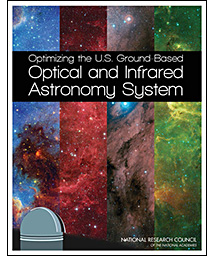Optimizing the US Ground-Based OIR Astronomy System
Debra Elmegreen President, IAU
On 14 April, appropriately the day there was a Chilean stone-laying ceremony celebrating the start of construction on the Large Synoptic Survey Telescope (LSST), I was in Washington, DC, to present the report of the National Research Council (NRC) Committee on a Strategy to Optimize the US Optical and Infrared (OIR) System in the Era of the Large Synoptic Survey Telescope (LSST). The National Science Foundation (NSF) Division of Astronomical Sciences (AST) requested this study upon advice from NSF's Astronomy and Astrophysics Advisory Committee (AAAC) and the NRC’s Committee on Astronomy and Astrophysics and in discussions with the NRC. We were tasked with defining the current US OIR system of public and private facilities and recommending strategies, capabilities, and expertise needed in order to help address the science objectives of the decadal surveys and to achieve the best science return from federal investments. The NRC study director was David Lang, and my hard-working committee included Todd Boroson, Debra Fischer, Joshua Frieman, Lynne Hillenbrand, Buell Jannuzi, Robert Kirshner, Lori Lubin, Robert Lupton, Paul Schechter, Paul Vanden Bout, and Craig Wheeler; the AAS's Director of Public Policy, Joel Parriott, served as a consultant to the committee.
Based on the decadal survey reports New Worlds, New Horizons in Astronomy and Astrophysics and Vision and Voyages for Planetary Science, along with the NSF Portfolio Review report and community input in the form of white papers co-authored by more than 300 astronomers, observatory surveys, and meeting presentations by observatory directors and specialists in a variety of topics, we developed three guiding principles to help inform our decisions:
- An integrated OIR system can achieve the best science when it engages a broad population of astronomers to pursue a diversity of science and scientific approaches.
- Federal investment in LSST follow-up capabilities and in community-prioritized instrumentation across the OIR system will help to maximize scientific output.
- Federal support to sustain technology, instrumentation, and software development, and expertise in these fields, is necessary to optimize future science returns.
We then developed several main recommendations and a number of conclusions. The recommendations include these:
- A strategy for improving the system through a telescope and data exchange program fostering sharing of resources and access to the community,
- An ongoing community-wide planning process that would identify and help develop small and medium needs between decadal surveys,
- Decadal-identified needed instruments, including a wide-field massively multiplexed spectrograph and a high-throughput moderate-resolution spectrograph,
- Development of event brokers and coordinated follow-up capabilities for LSST science, including coordination of Gemini South, Blanco, and SOAR,
- Technology development, including detectors, adaptive/active optics, and extreme-precision radial-velocity instruments,
- Federal investment in giant segmented-mirror telescopes (GSMTs), and
- Training networks to develop future expertise in areas such as big-data software and instrumentation.
The main conclusions aside from the recommendations involved discussions about the need for public well-curated archives from big surveys, the possible future roles of the Dark Energy Spectroscopic Instrument (DESI) and the Dark Energy Camera (DECam), the coordination of the federally controlled components of Southern Hemisphere telescopes for science, including LSST-related observations, and international discussions involving time and data exchanges.
We briefed the staff at the NSF AST division, the White House Office of Science and Technology Policy (OSTP) and Office of Management and Budget OMB), and the Senate Committee for Commerce, Justice, Science, and Related Agencies. We look forward to seeing the outcomes of our report in the coming months and years.
The full report is available on the National Academies webpage.


